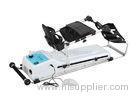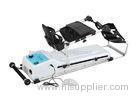

Multipurpose CPM Machine Lower Limb Continuous Passive Motion with several speed set
| Place of Origin: | Zhejiang |
|---|
Company Profile
| Location: | Hangzhou, Zhejiang, China (Mainland) |
|---|---|
| Business Type: | Manufacturer |
| Main Products: | CPM Medical Equipment, Knee CPM Machine, Shoulder CPM Machine |
Product Detail
| Model No.: | YTK-C |
|---|
Product Description
Multipurpose CPM Machine Lower Limb Continuous Passive Motion with several speed set
Quick Detail:
Size: 930x400x410mm
Weight: 20kg
Length : 50cm
Range of motion: -5-120 degree
Range of ankle: 0-40 degree
Speed: 0.5-3.5 degree/s
Working time: 0-240min
Application: keen .coxa and ankle joint.
Motor power: 30 Q Mechanical Output
Maximum carrying force: 140kg.
Description:
CPM Continuous Passive Motion for lower limb, Active cum passive inbuilt with stimulator with Remote control
CPM Machine (CPM) is one of the primary methods for decreasing the deleterious effects of immobilization and can deliver orthopedic, neurological, and even circulatory benefits to the patient. Immobilization, in turn, can create deleterious sequelae of physiological and functional impairments.
Applications:
The lower limbs CPM is used to help the patients to do Rehabilitation suit for Keen, Coxa and ankle joint..
Specifications:
The ROM and working speed of the device is adjustable.
The knee joint of the device moves in constant angular velocity at the adjusted value.
The patient can immediately interfere the working of the device with the aid of pendant.
The device supports a large ROM with the aid of special design.
The device works safely and problem free with the aid of special brush less dc motor.
Very powerful motor that can provide an 50 daN of horizontal force.
Reverses on excessive loads in order to protect patient safety.
Telescopic bed spacing bars in order to adjust the space between the bed and device.
Competitive Advantage:
CPU control setting ,display and controlled by both machine and motion controller.
Can automatically run by angle control or speed control
Can automatically controlled, including motion angle range and speed
Have the function of torque setting,
Use the motion support fitting for physiology curve


